 | –≠–ª–µ–∫—Ç—Ä–æ–Ω–Ω—ã–π –∫–æ–º–ø–æ–Ω–µ–Ω—Ç: TMP12EB | –°–∫–∞—á–∞—Ç—å:  PDF PDF  ZIP ZIP |
TMP12 Data Sheet.p65 (Rev.)

REV. A
Information furnished by Analog Devices is believed to be accurate and
reliable. However, no responsibility is assumed by Analog Devices for its
use, nor for any infringements of patents or other rights of third parties that
may result from its use. No license is granted by implication or otherwise
under any patent or patent rights of Analog Devices.
a
One Technology Way, P.O. Box 9106, Norwood, MA 02062-9106, U.S.A.
Tel: 781/329-4700
www.analog.com
Fax: 781/326-8703
© Analog Devices, Inc., 2002
Airflow and Temperature Sensor
FUNCTIONAL BLOCK DIAGRAM
HYSTERESIS
CURRENT
CURRENT
MIRROR
TMP12
I
HYS
WINDOW
COMPARATOR
HYSTERESIS
VOLTAGE
1k
100
VOLTAGE
REFERENCE
AND
SENSOR
V
REF
SET
HIGH
SET
LOW
GND
V+
OVER
UNDER
HEATER
PIN CONNECTIONS
8-Lead SOIC
TOP VIEW
(Not to Scale)
8
7
6
5
1
2
3
4
V
REF
V+
TMP12
SET HIGH
OVER
SET LOW
UNDER
GND
HEATER
FEATURES
Temperature Sensor Includes 100 Heater
Heater Provides Power IC Emulation
Accuracy 3 Typ from ≠40 C to +100 C
Operation to 150 C
5 mV/ C Internal Scale-Factor
Resistor Programmable Temperature Setpoints
20 mA Open-Collector Setpoint Outputs
Programmable Thermal Hysteresis
Internal 2.5 V Reference
Single 5 V Operation
400 A Quiescent Current (Heater Off)
Minimal External Components
APPLICATIONS
System Airflow Sensor
Equipment Over-Temperature Sensor
Over-Temperature Protection
Power Supply Thermal Sensor
Low-Cost Fan Controller
TMP12
*
*Protected by U.S. Patent No. 5,195,827.
Pentium is a registered trademark of Intel Corporation.
GENERAL DESCRIPTION
The TMP 12 is a silicon-based airflow and temperature sensor
designed to be placed in the same airstream as heat generating
components that require cooling. Fan cooling may be required
continuously, or during peak power demands, e.g., for a power
supply; and if the cooling systems fails, system reliability and/or
safety may be impaired. By monitoring temperature while emu-
lating a power IC, the TMP12 can provide a warning of cooling
system failure.
The TMP12 generates an internal voltage that is linearly propor-
tional to Celsius (Centigrade) temperature, nominally 5 mV/
∞C.
The linearized output is compared with voltages from an exter-
nal resistive divider connected to the TMP12's 2.5 V precision
reference. The divider sets up one or two reference voltages, as
required by the user, providing one or two temperature setpoints.
Comparator outputs are open-collector transistors able to sink
over 20 mA. There is an on-board hysteresis generator provided
to speed up the temperature-setpoint output transitions, this
also reduces erratic output transitions in noisy environments.
Hysteresis is programmed by the external resistor chain and
is determined by the total current drawn from the 2.5 V reference.
The TMP12 airflow sensor also incorporates a precision, low
temperature coefficient 100
heater resistor that may be con-
nected directly to an external 5 V supply. When the heater is
activated, it raises the die temperature in the DIP package
approximately 20
∞C above ambient (in still air). The purpose of
the heater in the TMP12 is to emulate a power IC, such as a
regulator or Pentium
Æ
CPU, which has a high internal dissipation.
When subjected to a fast airflow, the package and die tempera-
tures of the power device and the TMP12 (if located in the
same airstream) will be reduced by an amount proportional to
the rate of airflow. The internal temperature rise of the TMP12
may be reduced by placing a resistor in series with the heater, or
reducing the heater voltage.
The TMP12 is intended for single 5 V supply operation, but will
operate on a 12 V supply. The heater is designed to operate from
5 V only. Specified temperature range is from ≠40
∞C to +125∞C,
operation extends to 150
∞C at 5 V with reduced accuracy.
The TMP12 is available in 8-pin SO packages.

REV. A
≠2≠
TMP12≠SPECIFICATIONS
Parameter
Symbol
Conditions
Min
Typ
Max
Unit
ACCURACY
Accuracy (High, Low Setpoints)
T
A
= 25
∞C
±2
±3
∞C
T
A
= ≠40
∞C to +100∞C
±3
±5
∞C
Internal Scale Factor
T
A
= ≠40
∞C to +100∞C
4.9
5
5.1
mV/
∞C
Power Supply Rejection Ratio
PSRR
4.5 V
V
S
5.5 V
0.1
0.5
∞C/V
Linearity
T
A
= ≠40
∞C to +125∞C
0.5
∞C
Repeatability
T
A
= ≠40
∞C to +125∞C
0.3
∞C
Long Term Stability
T
A
= 125
∞C for 1 k Hrs
0.3
∞C
SETPOINT INPUTS
Offset Voltage
V
OS
0.25
mV
Output Voltage Drift
TCV
OS
3
µV/∞C
Input Bias Current
I
B
25
100
nA
VREF OUTPUT
Output Voltage
VREF
T
A
= 25
∞C, No Load
2.49
2.50
2.51
V
VREF
T
A
= ≠40
∞C to +100∞C, No Load
2.5
± 0.015
V
Output Drift
TC
VREF
≠10
ppm/
∞C
Output Current, Zero Hysteresis
I
VREF
7
µA
Hysteresis Current Scale Factor
SF
HYS
5
µA/∞C
OPEN-COLLECTOR OUTPUTS
Output Low Voltage
V
OL
I
SINK
= 1.6 mA
0.25
0.4
V
V
OL
I
SINK
= 20 mA
0.6
V
Output Leakage Current
I
OH
V
S
= 12 V
1
100
µA
Fall Time
t
HL
See Test Load
40
ns
HEATER
Resistance
R
H
T
A
= 125
∞C
97
100
103
Temperature Coefficient
T
A
= ≠40
∞C to +125∞C
100
ppm/
∞C
Maximum Continuous Current
1
I
H
60
mA
POWER SUPPLY
Supply Range
V
S
4.5
5.5
V
Supply Current
I
SY
Unloaded at 5 V
400
600
µA
I
SY
Unloaded at 12 V
2
450
µA
NOTES
1
Guaranteed but not tested.
2
TMP12 is specified for operation from a 5 V supply. However, operation is allowed up to a 12 V supply, but not tested at 12 V. Maximum heater supply is 6 V.
Specifications subject to change without notice.
1k
20pF
Figure 1. Test Load
(V
S
= 5 V, ≠40 C
T
A
s
125 C unless otherwise noted.)

REV. A
TMP12
≠3≠
CAUTION
ESD (electrostatic discharge) sensitive device. Electrostatic charges as high as 4000 V readily
accumulate on the human body and test equipment and can discharge without detection. Although
the TMP12 features proprietary ESD protection circuitry, permanent damage may occur on
devices subjected to high-energy electrostatic discharges. Therefore, proper ESD precautions are
recommended to avoid performance degradation or loss of functionality.
WARNING!
ESD SENSITIVE DEVICE
ABSOLUTE MAXIMUM RATINGS
*
Supply Voltage . . . . . . . . . . . . . . . . . . . . . . . . ≠0.3 V to +11 V
Heater Voltage . . . . . . . . . . . . . . . . . . . . . . . . . . . . . . . . . . 6 V
Setpoint Input Voltage . . . . . . . . . . . ≠0.3 V to [(V+) + 0.3 V]
Reference Output Current . . . . . . . . . . . . . . . . . . . . . . . 2 mA
Open-Collector Output Current . . . . . . . . . . . . . . . . . 50 mA
Open-Collector Output Voltage . . . . . . . . . . . . . . . . . . . . 15 V
Operating Temperature Range . . . . . . . . . . ≠55
∞C to +150∞C
Storage Temperature Range . . . . . . . . . . . . ≠65
∞C to +160∞C
Lead Temperature (Soldering, 60 sec) . . . . . . . . . . . . 300
∞C
Package Type
JA
JC
Unit
8-Lead SOIC (S)
158
2
43
∞C/W
NOTES
1
JA
is specified for device in socket (worst case conditions).
2
JC
is specified for device mounted on PCB.
CAUTION
1. Stresses above those listed under Absolute Maximum Ratings
may cause permanent damage to the device. This is a stress
rating only and functional operation at or above this specifi-
cation is not implied. Exposure to the above maximum rating
conditions for extended periods may affect device reliability.
2. Digital inputs and outputs are protected; however, permanent
damage may occur on unprotected units from high-energy
electrostatic fields. Keep units in conductive foam or packag-
ing at all times until ready to use. Use proper antistatic handling
procedures.
3. Remove power before inserting or removing units from their
sockets.
ORDERING GUIDE
Temperature
Package
Package
Model/Grade
Range
1
Description
Option
TMP12FS
2
XIND
SOIC
SO-8
NOTES
1
XIND = ≠40
∞C to +125∞C
2
Not for new design, obsolete April 2002.
FUNCTIONAL DESCRIPTION
The TMP12 incorporates a heating element, temperature sensor,
and two user-selectable setpoint comparators on a single substrate.
By generating a known amount of heat, and using the setpoint
comparators to monitor the resulting temperature rise, the TMP12
can indirectly monitor the performance of a system's cooling fan.
The TMP12 temperature sensor section consists of a band gap
voltage reference which provides both a constant 2.5 V output
and a voltage which is proportional to absolute temperature
(VPTAT). The VPTAT has a precise temperature coefficient of
5 mV/K and is 1.49 V (nominal) at 25
∞C. The comparators
compare VPTAT with the externally set temperature trip points
and generate an open-collector output signal when one of their
respective thresholds has been exceeded.
The heat source for the TMP12 is an on-chip 100
low tempco
thin-film resistor. When connected to a 5 V source, this resistor
dissipates:
P
V
R
V
W
D
=
=
=
2
2
5
100
0 25
.
which generates a temperature rise of about 32
∞C in still air for
the SO packaged device. With an airflow of 450 feet per minute
(FPM), the temperature rise is about 22
∞C. By selecting a tem-
perature setpoint between these two values, the TMP12 can
provide a logic-level indication of problems in the cooling system.
A proprietary, low tempco thin-film resistor process, in conjunction
with production laser trimming, enables the TMP12 to provide a
temperature accuracy of
±3∞C (typ) over the rated temperature
range. The open-collector outputs are capable of sinking 20 mA,
allowing the TMP12 to drive small control relays directly. Oper-
ating from a single 5 V supply, the quiescent current is only
600
µA (max), without the heater resistor current.
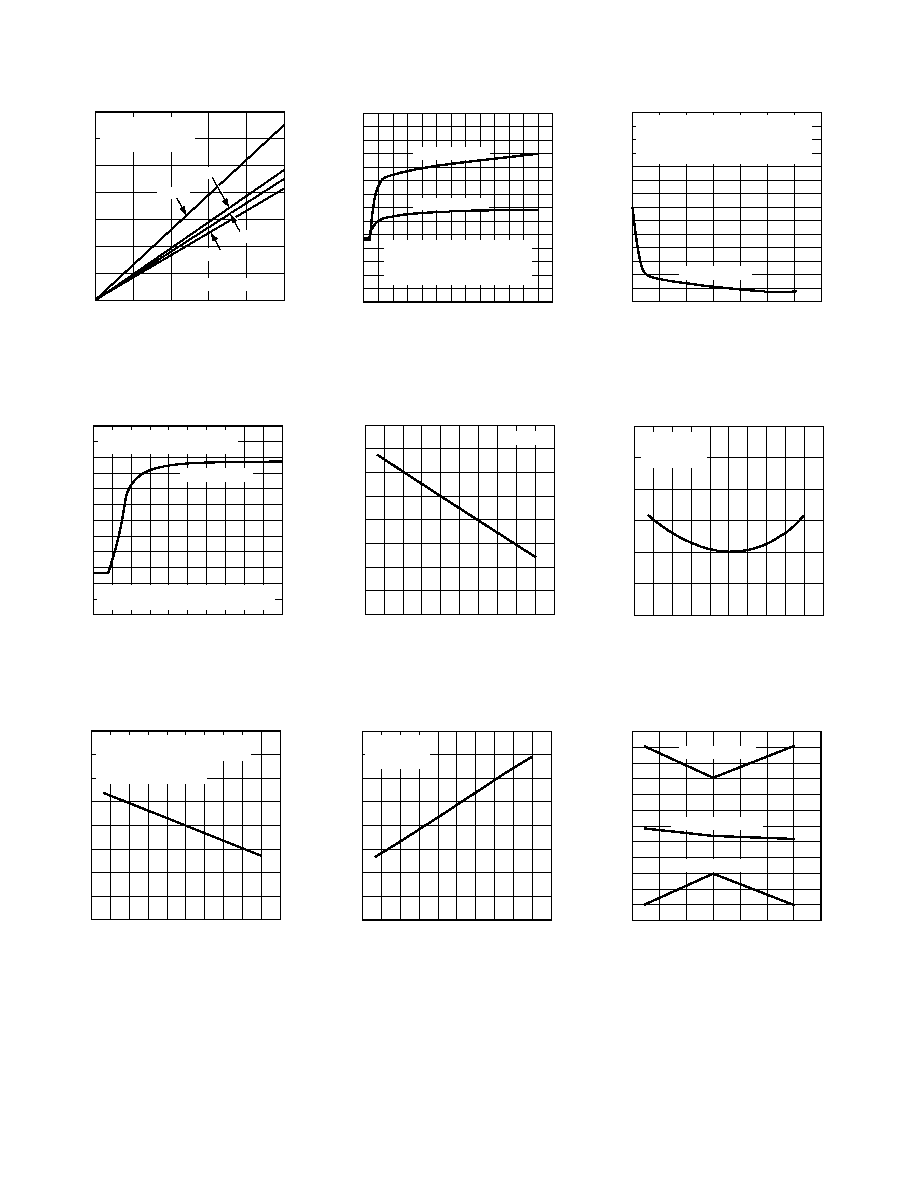
REV. A
TMP12
≠4≠
≠Typical Performance Characteristics
HEATER RESISTOR POWER
DISSIPATION ≠ mW
JUNCTION TEMPERA
T
URE
RISE
ABO
VE AMBIENT ≠ 8C
35
0
30
25
20
15
10
5
0
50
100
150
200
250
V+ = 5V
SO-8 SOLDERED TO
0.5 0.3 CU PCB
0 FPM
250 FPM
600 FPM
AIR FLOW RATES
450 FPM
TPC 1. SOIC Junction Temperature
Rise vs. Heater Dissipation
TIME ≠ sec
JUNCTION TEMPERA
T
URE
≠
C
120
0
110
100
90
80
70
60
50
40
30
20
10
0
2
4
6
8
10 12
14
16 18
20
TRANSITION FROM STILL 25 C
AIR TO STIRRED 100 C BATH
V+ = 5V, NO LEAD, HEATER OFF
SO-8 SOLDERED TO 0.5 0.3 CU PCB
SOIC AND PCB
TPC 4. Thermal Response Time in
Stirred Oil Bath
TEMPERATURE ≠ C
ST
AR
T
-
UP SUPPL
Y
V
O
L
T
A
GE
≠
V
5.0
≠75
4.5
4.0
3.5
≠25
25
75
125
175
3.0
START-UP VOLTAGE DEFINED AS
OUTPUT READING BEING WITHIN
C OF OUTPUT AT 5V
NO LEAD, HEATER OFF
TPC 7. Start-Up Voltage vs.
Temperature
TIME ≠ sec
JUNCTION TEMPERA
T
URE
≠
C
70
0
65
60
55
50
45
40
35
30
25
20
15
10
5
0
10 20 30 40 50 60 70 80 90 100 110120 130
SO-8, HTR @ 5V
SO-8, HTR @ 3V
V+ = 5V RHEATER TO EXTERNAL
SUPPLY TURNED ON @
t
= 5 sec
SO-8 SOLDERED TO 0.5 8 0.3
COPPER PCB
TPC 2. Junction Temperature Rise in
Still Air
TEMPERATURE ≠ C
HEA
TER RESIST
ANCE
≠
102.0
≠75
101.5
101.0
100.5
100.0
99.5
99.0
98.5
98.0
≠25
25
75
125
175
V+ = 5V
TPC 5. Heater Resistance vs.
Temperature
TEMPERATURE ≠ C
SUPPL
Y CURRENT
≠
A
500
≠75
475
450
425
400
375
350
325
300
≠25
25
75
125
175
V+ = 5V
NO LEAD
HEATER OFF
TPC 8. Supply Current vs.
Temperature
AIR VELOCITY ≠ FPM
TIME CONST
ANT
≠
sec
140
0
130
120
110
100
90
80
70
60
50
40
30
20
10
0
100
200
300
400
500
600
700
TRANSITION FROM 100 C STIRRED
BATH TO FORCED 25 C AIR
V+ = 5V, NO LEAD, HEATER OFF
SO-8 SOLDERED TO 0.5 0.3 CU PCB
SOIC AND PCB
TPC 3. Package Thermal Time
Constant in Forced Air
TEMPERATURE ≠ C
REFERENCE V
O
L
T
A
GE
≠
V
2.520
≠75
2.515
2.510
2.505
2.500
2.495
2.490
≠25
25
75
125
175
V+ = 5V
NO LOAD
HEATER OFF
TPC 6. Reference Voltage vs.
Temperature
TEMPERATURE ≠ C
A
CCURA
CY ERR
OR
≠
C
6
≠50
5
4
3
2
1
0
≠1
≠2
≠3
≠4
≠5
≠6
≠25
0
25
50
75
100
125
MAXIMUM LIMIT
ACCURACY ERROR
MINIMUM LIMIT
TPC 9. Accuracy Error vs.
Temperature

REV. A
≠5≠
TMP12
SUPPLY VOLTAGE ≠ V
SUPPL
Y CURRENT
≠
A
500
0
450
400
350
300
250
200
150
100
50
0
1
2
3
4
5
6
7
8
T
A
= 25 C
NO LOAD
HEATER OFF
TPC 10. Supply Current vs. Supply
Voltage
TEMPERATURE ≠ C
PO
WER SUPPL
Y REJECTION
≠
C/V
0.5
≠75
0.4
0.3
0.2
0.1
0
≠25
25
75
125
175
V+ = 4.5V TO 5.5V
NO LOAD
HEATER OFF
TPC 11. VPTAT Power Supply
Rejection vs. Temperature
TEMPERATURE ≠ C
OPEN COLLECTION SINK CURRENT
≠
mA
40
≠75
36
32
28
24
20
≠25
25
75
125
175
38
34
30
26
22
V
OL
= 1V
V+ = 5V
TPC 12. Open-Collector Output Sink
Current vs. Temperature
APPLICATIONS INFORMATION
A typical application for the TMP12 is shown in Figure 2. The
TMP12 package is placed in the same cooling airflow as a high-
power dissipation IC. The TMP12's internal resistor produces a
temperature rise that is proportional to air flow, as shown in
Figure 3. Any interruption in the air flow will produce an addi-
tional temperature rise. When the TMP12 chip temperature
exceeds a user-defined setpoint limit, the system controller can
take corrective action, such as, reducing clock frequency, shutting
down unneeded peripherals, turning on additional fan cooling,
or shutting down the system.
PGA
PACKAGE
PGA
SOCKET
POWER I.C.
AIR FLOW
PC BOARD
TMP12
Figure 2. Typical Application
TEMPERATURE ≠ C
OPEN COLLECTION SINK CURRENT
≠
mA
700
≠75
500
300
100
≠25
25
75
125
175
600
400
200
0
LOAD = 10mA
LOAD = 5mA
LOAD = 1mA
TPC 13. Open-Collector Voltage vs.
Temperature
TMP12 P
D
≠ mW
65
60
35
0
250
50
DIE TEMPERA
T
URE
≠
C
100
150
200
55
50
45
40
A
B
C
D
E
A. TMP12 DIE TEMP NO AIR FLOW
B. HIGH SET POINT
C. LOW SET POINT
D. TMP12 DIE TEMP MAX AIR FLOW
E. SYSTEM AMBIENT TEMPERATURE
Figure 3. Choosing Temperature Setpoints
Temperature Hysteresis
The temperature hysteresis at each setpoint is the number of
degrees beyond the original setpoint temperature that must be
sensed by the TMP12 before the setpoint comparator will be
reset and the output disabled. Hysteresis prevents
chatter and
motorboating in feedback control systems. For monitoring tem-
perature in computer systems, hysteresis prevents multiple
interrupts to the CPU which can reduce system performance.

REV. A
TMP12
≠6≠
Figure 4 shows the TMP12's hysteresis profile. The hysteresis is
programmed, by the user, by setting a specific load current on
the reference voltage output V
REF
. This output current, I
REF
, is
also called the hysteresis current. I
REF
is mirrored internally by
the TMP12, as shown in the Functional Block Diagram, and
fed to a buffer with an analog switch.
HYSTERESIS
LOW
HYSTERESIS
HIGH
HYSTERESIS HIGH =
HYSTERESIS LOW
TEMPERATURE
T
SETLOW
T
SETHIGH
HI
LO
OUTPUT
VOLTAGE
OVER, UNDER
Figure 4. Hysteresis Profile
After a temperature setpoint has been exceeded and a compara-
tor tripped, the hysteresis buffer output is enabled. The result is
a current of the appropriate polarity, which generates a hyster-
esis offset voltage across an internal 1 k
resistor at the
comparator input. The comparator output remains on until the
voltage at the comparator input, now equal to the temperature
sensor voltage VPTAT summed with the hysteresis effect, has
returned to the programmed setpoint voltage. The comparator
then returns LOW, deactivating the open-collector output and
disabling the hysteresis current buffer output. The scale factor
for the programmed hysteresis current is:
I
I
A
C
A
VREF
=
=
∞ +
5
7
µ
µ
/
Thus, since VREF = 2.5 V, a reference load resistance of 357 kQ
or greater (output current of 7
µA or less) will produce a tempera-
ture setpoint hysteresis of zero degrees. For more details, see the
temperature programming discussion below. Larger values of
load resistance will only decrease the output current below but
will have no effect on the operation of the device. The amount
of hysteresis is determined by selecting an appropriate value of
load resistance for VREF, as shown below.
Programming the TMP12
The basic thermal monitoring application only requires a simple
three-resistor ladder voltage divider to set the high and low
setpoints and the hysteresis. These resistors are programmed in
the following sequence:
1. Select the desired hysteresis temperature.
2. Calculate the hysteresis current, I
VREF
.
3. Select the desired setpoint temperatures.
4. Calculate the individual resistor divider ladder values needed
to develop the desired comparator setpoint voltages at the
Set High and Set Low inputs.
The hysteresis current is readily calculated, as shown above. For
example, to produce two degrees of hysteresis, I
VREF
should be
set to 17
µA. Next, the setpoint voltages V
SETHIGH
and V
SETLOW
are determined using the VPTAT scale factor of
5
5
273 15
mV K
mV
C
/
/
.
=
∞ +
(
)
which is 1.49 V for 25
∞C. Finally, the divider resistors are calcu-
lated, based on the setpoint voltages.
The setpoint voltages are calculated from the equation:
V
T
mV C
SET
SET
=
+
(
)
∞
(
)
273 15 5
.
/
This equation is used to calculate both the V
SETHIGH
and the
V
SETLOW
values. A simple 3-resistor network, as shown in Figure 5,
determines the setpoints and hysteresis value. The equations
used to calculate the resistors are:
R
k
V
V
I
V
V
I
REF
SETHIGH
VREF
SETHIGH
VREF
1
2 5
( )
=
(
)
=
(
)
≠
/
.
≠
/
R
k
V
V
I
SETHIGH
SETLOW
VREF
2
( )
=
(
)
≠
/
R
k
V
I
SETLOW
VREF
3
( )
=
/
V+
TMP12
V
SETHIGH
OVER
V
SETLOW
UNDER
GND
HEATER
1
8
2
7
3
6
4
5
|V
REF
(V
REF
≠ V
SETHIGH
)/|V
REF
= R1
(V
SETHIGH
≠ V
SETLOW
)/|V
REF
= R2
(V
SETLOW
≠ V
REF
)/|V
REF
= R3
V
REF
= 2.5V
Figure 5. Setpoint Programming
For example, setting the high setpoint for 80
∞C, the low setpoint
for 55
∞C, and hysteresis for 3∞C produces the following values:
I
I
C
A C
A
A
A
A
HYS
VREF
=
= ∞ ◊
∞
(
)
+
=
+
=
3
5
7
15
7
22
µ
µ
µ
µ
µ
/
V
T
mV
C
C
mV
C
V
SETHIGH
SETHIGH
=
+
(
)
∞
(
)
=
∞ +
(
)
∞
(
)
=
273 15 5
80
273 15 5
1 766
.
/
.
/
.
V
T
mV
C
C
mV
C
V
SETLOW
SETLOW
=
+
(
)
∞
(
)
=
∞ +
(
)
∞
(
)
=
273 15 5
55
273 15 5
1 641
.
/
.
/
.
R
k
VREF V
I
V
V
A
k
SETHIGH
VREF
1
2 5
1 766
22
33 36
( )
=
(
)
=
(
)
=
≠
/
.
≠ .
/
.
µ
R
k
V
V
I
V
V
A
k
SETHIGH
SETLOW
VREF
2
1 766
1 641
22
5 682
( )
=
(
)
=
(
)
=
≠
/
.
≠ .
/
.
µ
R
k
V
I
V
A
k
SETLOW
VREF
3
1 641
22
74 59
( )
=
=
(
)
=
/
.
/
.
µ
The total of
R1 + R2 + R3 is equal to the load resistance needed to
draw the desired hysteresis current from the reference, or I
VREF
.
The nomograph of Figure 6 provides an easy method of determin-
ing the correct VPTAT voltage for any temperature. Simply locate
the desired temperature on the appropriate scale (K,
∞C, or ∞F)
and read the corresponding VPTAT value from the bottom scale.
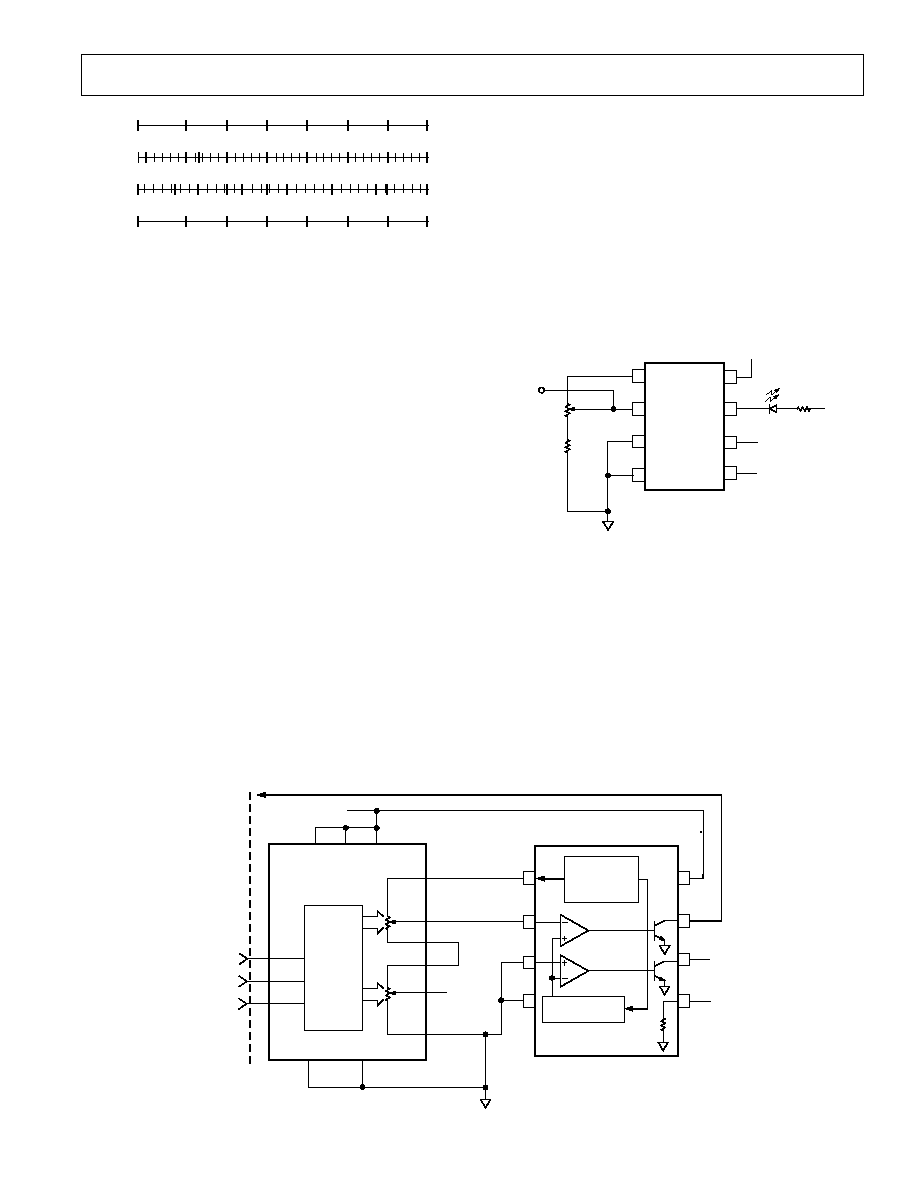
REV. A
TMP12
≠7≠
K
C
F
VPTAT
218
248
273
298
323
348
373
398
≠55
≠25 ≠18
0
25
50
75
100
125
≠67
1.09
≠25
0
32 50
77 100
150
200 212
257
1.24
1.365
1.49
1.615
1.74
1.865
1.99
Figure 6. Temperature, VPTAT Scale
The formulas shown above are also helpful in understanding the
calculations of temperature setpoint voltages in circuits other
than the standard two-temperature thermal/airflow monitor. If a
setpoint function is not needed, the appropriate comparator
input should be disabled. SETHIGH can be disabled by tying it
to V+ or VREF, SETLOW by tying it to GND. Either output
can be left disconnected.
Selecting Setpoints
Choosing the temperature setpoints for a given system is an
empirical process, because of the wide variety of thermal issues
in any practical design. The specific setpoints are dependent on
such factors as airflow velocity in the system, adjacent component
location and size, PCB thickness, location of copper ground
planes, and thermal limits of the system.
The TMP12's temperature rise above ambient is proportional
to airflow (TPC 1 and Figure 2). As a starting point, the low
setpoint temperature could be set at the system ambient tem-
perature (inside the enclosure) plus one-half of the temperature
rise above ambient (at the actual airflow in the system). With
this setting, the low limit will provide a warming either if the fan
output is reduced or if the ambient temperature rises (for example,
if the fan's cool air intake is blocked). The high setpoint could
then be set for the maximum system temperature to provide a
final system shutdown control.
Measuring the TMP12 Internal Temperature
As previously mentioned, the TMPl2's VPTAT generator repre-
sents the chip temperature with a slope of 5 mV/K. In some
cases, selecting the setpoints is made easier if the TMPl2's inter-
nal VPTAT voltage (and therefore, the chip temperature) is
known. For example, the case temperature of a high power
microprocessor can be monitored with a thermistor, thermo-
couple, or other measurement method. The case temperature
can then be correlated with the TMP12's temperature to select
the setpoints.
The TMPl2's VPTAT voltage is not available externally, so indi-
rect methods must be used. Since the VPTAT voltage is applied
to the internal comparators, measuring the voltage at which the
digital output changes state will reflect the VPTAT voltage.
A simple method of measuring the TMP12 VPTAT is shown in
Figure 7. To measure VPTAT, adjust potentiometer R1 until
the LED turns ON. The voltage at Pin 2 of the TMP12 will
then match the TMP12's internal VPTAT.
TMP12
V
REF
SET
HIGH
SET
LOW
GND
V+
OVER
UNDER
HEATER
1
8
2
7
3
6
4
5
VPTAT
R1
200k
R1
200k
330
5V
5V
LED
NC
5V
NC = NO CONNECT
Figure 7. Measuring VPTAT with a Potentiometer
The method described in Figure 7 can be automated by replacing
the discrete resistors with a digital potentiometer. The improved
circuit, shown in Figure 8, permits the VPTAT voltage to be
monitored with a microprocessor or other digital controller. The
AD8402-100 provides two 100 k
potentiometers which are
adjusted to 8-bit resolution via a 3-wire serial interface. The
controller simply sweeps the wiper of potentiometer l from the
Al terminal to the Bl terminal (digital value = 0), while monitor-
ing the comparator output at Pin 7 of the TMP 12. When Pin 7
goes low, the voltage at Pin 2 equals the VPTAT voltage. This
circuit sweeps Pin 2's voltage from maximum to minimum, so
that the TMP12's setpoint hysteresis will not affect the reading.
NC
5V
NC = NO CONNECT
NC
13
12
14
3
4
2
A1
W1
B1
A2
W2
B2
1
5
AD8402≠100
DGND
AGND
SHDN
RS
V
DD
5V
9
8
7
OVER
CS
CLK
SDI
C
INTERFACE
8
7
6
5
1
2
3
4
TEMPERATURE
SENSOR AND
VOLTAGE
REFERENCE
V
REF
WINDOW
COMPARATOR
HYSTERESIS
GENERATOR
100
TMP12
VPTAT
Figure 8. Measuring VPTAT with a Digital Potentiometer

REV. A
TMP12
≠8≠
The circuit of Figure 8 provides approximately 1
∞C of resolution.
The two potentiometers divide
VREF by two, and the 8-bit
potentiometer further divides
VREF by 256, so the resolution is
Resolution
VREF
N
V
mV
=
˜ =
˜ =
2
2
2 5
2
28
4 9
.
.
where
VREF is the voltage reference output (Pin l of the TMP12)
and
N is the resolution of the AD8402. Since the VPTAT has a
slope of 5 mV/K, the AD8402 provides 1
∞C of resolution. The
adjustment range of this circuit extends from VREF/2 (i.e.,
1.25 V, or ≠23
∞C) to VREF ≠ 1 LSB (i.e., 2.5 V ≠ 4.9 mV, or
226
∞C). The VPTAT is therefore
VPTAT
V
Digital Count
mV
=
+
◊
(
)
1 25
4 9
.
.
where
Digital Count is the value sent to the AD8402 which caused
the setpoint 1 output to go LOW.
A third way to measure the VPTAT voltage is to close a feed-
back loop around one of the TMPl2's comparators. This causes
the comparator to oscillate, and in turn forces the voltage at the
comparator input to equal the VPTAT voltage. Figure 9 is a
typical circuit for this measurement. An OP193 operational
amplifier, operating as an integrator, provides additional loop-gain
to ensure that the TMP12 comparator will oscillate.
Understanding Error Sources
The accuracy of the VPTAT sensor output is well characterized
and specified; however, preserving this accuracy in a thermal
monitoring control system requires some attention to minimiz-
ing the various potential error sources. The internal sources
of setpoint programming error include the initial tolerances and
temperature drifts of the reference voltage VREF, the setpoint
comparator input offset voltage and bias current, and the hysteresis
current scale factor. When evaluating setpoint programming
errors, remember that any VREF error contribution at the com-
parator inputs is reduced by the resistor divider ratios. Each
comparator's input bias current drops to less than l nA (typ) when
the comparator is tripped. This change accounts for some setpoint
voltage error, equal to the change in bias current multiplied by
the effective setpoint divider ladder resistance to ground.
The thermal mass of the TMP12 package and the degree of
thermal coupling to the surrounding circuitry are the largest
factors in determining the rate of thermal settling, which ultimately
determines the rate at which the desired temperature measure-
ment accuracy may be reached. (See graph in TPC 2.) Thus,
one must allow sufficient time for the device to reach the final
temperature. The typical thermal time constant for the SOIC
plastic package is approximately 70 seconds in still air. There-
fore, to reach the final temperature accuracy within 1%, for a
temperature change of 60 degrees, a settling time of five time
constants, or six minutes, is necessary. Refer to TPC 3.
External error sources to consider are the accuracy of the external
programming resistors, grounding error voltages, and thermal
gradients. The accuracy of the external programming resistors
directly impacts the resulting setpoint accuracy. Thus, in fixed-
temperature applications, the user should select resistor tolerances
appropriate to the desired programming accuracy. Since setpoint
resistors are typically located in the same air flow as the TMP12,
resistor temperature drift must be taken into account also. This
effect can be minimized by selecting good quality components,
and by keeping all components in close thermal proximity.
Careful circuit board layout and to minimize common thermal
error sources. Also, the user should take care to keep the bottom
of the setpoint programming divider ladder as close to GND
(Pin 4) as possible to minimize errors due to IR voltage drops
and coupling of external noise sources. In any case, a 0.1
µF
capacitor for power supply bypassing is always recommended at
the chip.
Safety Considerations in Heating and Cooling System Design
Designers should anticipate potential system fault conditions
that may result in significant safety hazards which are outside
the control of and cannot be corrected by the TMP12-based
circuit. Governmental and industrial regulations regarding
safety requirements and standards for such designs should be
observed where applicable.
Self-Heating Effects
In some applications the user should consider the effects of self
heating due to the power dissipated by the open-collector out-
puts, which are capable of sinking 20 mA continuously. Under
full load, the TMP12 open-collector output device is dissipating
P
V
A
mW
DISS
=
◊
=
0 6
0 020
12
.
.
which in a surface-mount SO package accounts for a tempera-
ture increase due to self-heating of
T P
W
C W
C
DISS
JA
=
◊
=
◊
∞
=
∞
0 012
158
1 9
.
/
.
This increase is for still air, of course, and will be reduced at
high airflow levels. However, the user should still be aware that
self-heating effects can directly affect the accuracy of the TMPl2.
For setpoint 2, self-heating will add to the setpoint temperature
(that is, in the above example the TMP12 will switch the setpoint
2 output off 1.9 degrees early). Self-heating will not affect the
temperature at which setpoint 1 turns on, but will add to the
hysteresis. Several circuits for adding external driver transistors
and other buffers are presented in the following sections of this
data sheet. These buffers will reduce self-heating and improve
accuracy.
Buffering the Voltage Reference
The reference output VREF is used to generate the temperature
setpoint programming voltages for the TMP12. Since the hyster-
esis is set by the reference current, external circuits which draw
current from the reference will increase the hysteresis value.
The on-board VREF output buffer is typically capable of 500
µA
output drive into as much as 50 pF load (max). Exceeding this
load will affect the accuracy of the reference voltage, could
cause thermal sensing error due to excess heat buildup, and
may induce oscillations. External buffering of VREF with a
low-drift voltage follower will ensure optimal reference accu-
racy. Amplifiers which offer low-drift, low-power consumption,
and low cost appropriate to this application include the OP284,
and members of the OP113, and OP193 families.
With excellent drift and noise characteristics, VREF offers a
good voltage reference for data acquisition and transducer exci-
tation applications as well. Output drift is typically better than
≠10 ppm/
∞C, with 315 nV/Hz (typ) noise spectral density at 1 kHz.

REV. A
TMP12
≠9≠
Preserving Accuracy Over Wide Temperature Range
Operation
The TMP12 is unique in offering both a wide-range temperature
sensor and the associated detection circuitry needed to imple-
ment a complete thermostatic control function in one monolithic
device. The voltage reference, setpoint comparators, and output
buffer amplifiers have been carefully compensated to maintain
accuracy over the specified temperature ranges in this applica-
tion. Since the TMP12 is both sensor and control circuit, in
many applications the external components used to program
and interface the device are subjected to the same temperature
extremes. Thus, it is necessary to place components in close
thermal proximity minimizing large temperate differentials, and
to account for thermal drift errors where appropriate, such as
resistor matching temperature coefficients, amplifier error drift,
and the like. Circuit design with the TMP12 requires a slightly
different perspective regarding the thermal behavior of electronic
components.
PC Board Layout Considerations
The TMP12 also requires a different perspective on PC board
layout. In many applications, wide traces and generous ground
planes are used to extract heat from components. The TMP12
is slightly different, in that ideal path for heat is via the cooling
system air flow. Thus, heat paths through the PC traces should
be minimized. This constraint implies that minimum pad sizes
and trace widths should be specified to reduce heat conduc-
tion. At the same time, analog performance should not be
compromised. In particular, the bottom of the setpoint resistor
ladder should be located as close to GND as possible, as
discussed in the Understanding Error Sources section of this
data sheet.
Thermal Response Time
The time required for a temperature sensor to settle to a specified
accuracy is a function of the thermal mass of the sensor, and
the thermal conductivity between the sensor and the object being
sensed. Thermal mass is often considered equivalent to capaci-
tance. Thermal conductivity is commonly specified using the
symbol Q, and is the inverse of thermal resistance. It is commonly
specified in units of degrees per watt of power transferred across
the thermal joint. TPC 2 and 4 illustrate the typical RC time con-
stant response to a step change in ambient temperature. Thus, the
time required for the TMP12 to settle to the desired accuracy is
dependent on the package selected, the thermal contact established
in the particular application, and the equivalent thermal conductiv-
ity of the heat source. For most applications, the settling-time is
probably best determined empirically.
Switching Loads with the Open-Collector Outputs
In many temperature sensing and control applications some type
of switching is required. Whether it be to turn on a heater when
the temperature goes below a minimum value or to turn off a
motor that is overheating, the open-collector outputs can be
used. For the majority of applications, the switches used need to
handle large currents on the order of 1 A and above. Because the
TMP12 is accurately measuring temperature, the open-collector
outputs should handle less than 20 mA of current to minimize
self-heating. Clearly, the trip point outputs should not drive the
equipment directly. Instead, an external switching device is
required to handle the large currents. Some examples of these
are relays, power MOSFETs, thyristors, IGBTs, and Darlington
transistors.
This section shows a variety of circuits where the TMP12 con-
trols a switch. The main consideration in these circuits, such as
the relay in Figure 10, is the current required to activate the switch.
NC
12V
NC = NO CONNECT
R1
R2
R3
IN4001
OR EQUIV
140
MOTOR
SHUTDOWN
2604-12-311
COTO
12V
8
7
6
5
1
2
3
4
TEMPERATURE
SENSOR AND
VOLTAGE
REFERENCE
V
REF
WINDOW
COMPARATOR
HYSTERESIS
GENERATOR
100
TMP12
VPTAT
Figure 10. Reed Relay Drive
It is important to check the particular relay you choose to ensure
that the current needed to activate the coil does not exceed the
TMP12's recommended output current of 20 mA. This is easily
determined by dividing the relay coil voltage by the specified
coil resistance. Keep in mind that the inductance of the relay
will create large voltage spikes that can damage the TMP12
output unless protected by a commutation diode across the coil,
as shown. The relay shown has a contact rating of 10 W maxi-
mum. If a relay capable of handling more power is desired, the
larger contacts will probably require a commensurably larger
coil, with lower coil resistance and thus higher trigger current.
As the contact power handling capability increases, so does the
OP193
VPTAT
200k
TMP12
V
REF
SET
HIGH
SET
LOW
GND
V+
OVER
UNDER
HEATER
1
8
2
7
3
6
4
5
5V
NC
5V
NC = NO CONNECT
NC
5V
300k
130k
1 F
≠1.5V
10k
0.1 F
Figure 9. An Analog Measurement Circuit for VPTAT
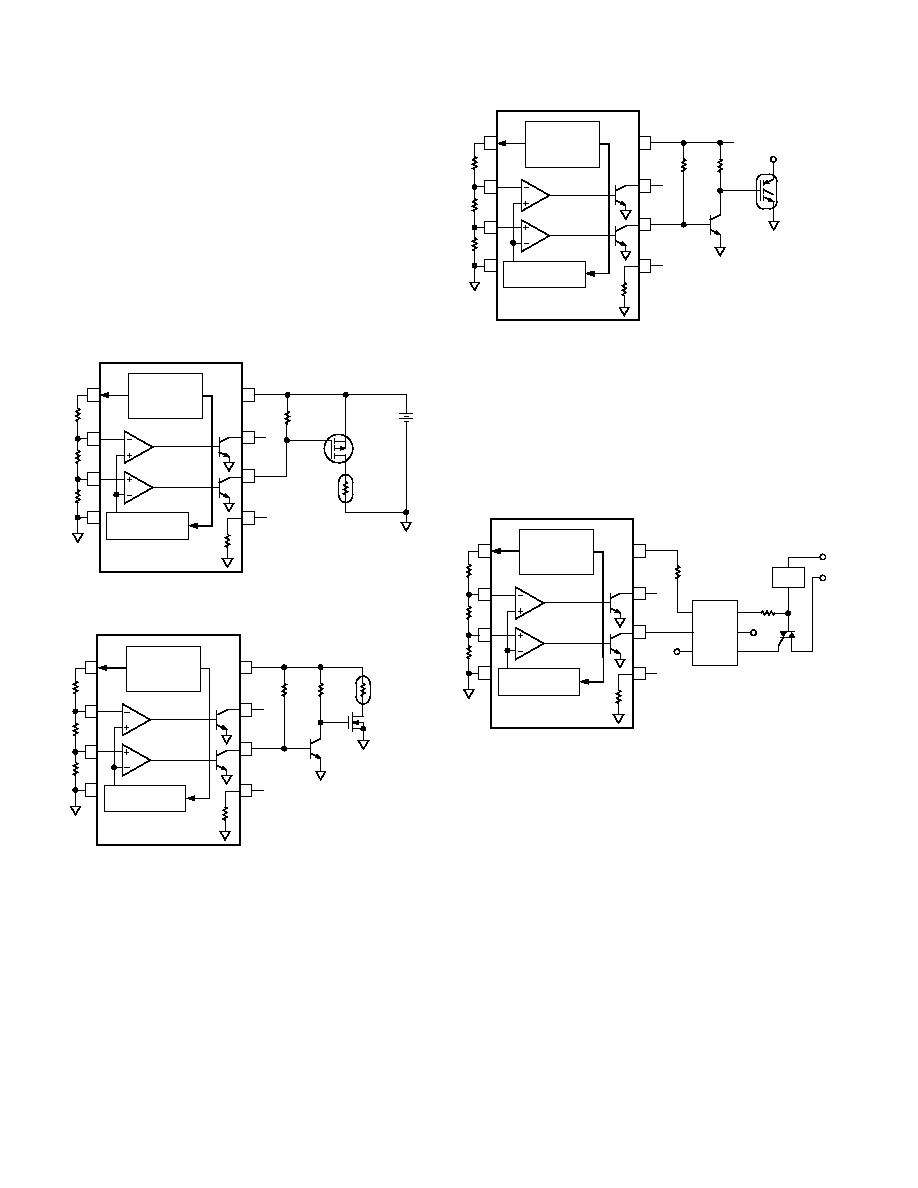
REV. A
TMP12
≠10≠
current needed for the coil. In some cases, an external driving
transistor should be used to remove the current load on the
TMPl2 as explained in the next section.
Power FETs are popular for handling a variety of high current
dc loads. Figure 11 shows the TMP12 driving a P-channel
MOSFET transistor for a simple heater circuit. When the output
transistor turns on, the gate of the MOSFET is pulled down to
approximately 0.6 V, turning it on. For most MOSFETs, a
gate-to-source voltage or Vgs on the order of ≠2 V to ≠5 V is
sufficient to turn the device on. Figure 12 shows a similar circuit
for turning on an N-channel MOSFET, except that now the
gate to source voltage is positive. For this reason, an external
transistor must be used as an inverter so that the MOSFET will
turn on when the trip point pulls down.
NC
NC = NO CONNECT
5V
2.4k (12V)
1.2k (6V)
5%
HEATING
ELEMENT
IRFR9024
OR EQUIV
+
V+
8
7
6
5
1
2
3
4
TEMPERATURE
SENSOR AND
VOLTAGE
REFERENCE
V
REF
WINDOW
COMPARATOR
HYSTERESIS
GENERATOR
100
TMP12
VPTAT
Figure 11. Driving a P-Channel MOSFET
NC
NC = NO CONNECT
5V
HEATING
ELEMENT
4.7k
4.7k
2N1711
IRF130
V+
8
7
6
5
1
2
3
4
TEMPERATURE
SENSOR AND
VOLTAGE
REFERENCE
V
REF
WINDOW
COMPARATOR
HYSTERESIS
GENERATOR
100
TMP12
VPTAT
Figure 12. Driving an N-Channel MOSFET
Isolated Gate Bipolar Transistors (IGBTs) combine many of the
benefits of power MOSFETs with bipolar transistors and are
used for a variety of high-power applications. Because IGBTs
have a gate similar to MOSFETs, turning on and off the devices
is relatively simple as shown in Figure 13. The turn on voltage
for the IGBT shown (IRGB40S) is between 3.0 V and 5.5 V.
This part has a continuous collector current rating of 50 A and a
maximum collector to emitter voltage of 600 V, enabling it to
work in very demanding applications.
NC
NC = NO CONNECT
5V
4.7k
4.7k
2N1711
IRGBC40S
MOTOR
CONTROL
V+
8
7
6
5
1
2
3
4
TEMPERATURE
SENSOR AND
VOLTAGE
REFERENCE
V
REF
WINDOW
COMPARATOR
HYSTERESIS
GENERATOR
100
TMP12
VPTAT
Figure 13. Driving an IGBT
The last class of high-power devices discussed here are Thyristors,
which include SCRs and Triacs. Triacs are a useful alternative
to relays for switching ac line voltages. The 2N6073A shown
in Figure 14 is rated to handle 4 A (rms). The opto-isolated
MOC3021 Triac shown features excellent electrical isolation
from the noisy ac line and complete control over the high-power
Triac with only a few additional components.
NC = NO CONNECT
NC
5V
300
V+ = 5V
MOC3011
150
LOAD
AC
2N6073A
8
7
6
5
1
2
3
4
TEMPERATURE
SENSOR AND
VOLTAGE
REFERENCE
V
REF
WINDOW
COMPARATOR
HYSTERESIS
GENERATOR
100
TMP12
VPTAT
Figure 14. Controlling the 2N6073A Triac
High Current Switching
As mentioned earlier, internal dissipation due to large loads on
the TMP12 outputs will cause some temperature error due to
self-heating. External transistors buffer the load from the TMP12
so that virtually no power is dissipated in the internal transistors
and minimal self-heating occurs. This section shows several
examples using external transistors. The simplest case uses a
single transistor on the output to invert the output signal is shown
in Figure 15. When the open-collector of the TMP12 turns "ON"
and pulls the output down, the external transistor Q1's base will
be pulled low, turning off the transistor. Another transistor can
be added to reinvert the signal as shown in Figure 16. Now,
when the output of the TMP12 is pulled down, the first transis-
tor, Q1, turns off and its collector goes high, which turns Q2 on,
pulling its collector low. Thus, the output taken from the collector
of Q2 is identical to the output of the TMP12. By picking a
transistor that can accommodate large amounts of current, many
high-power devices can be switched.
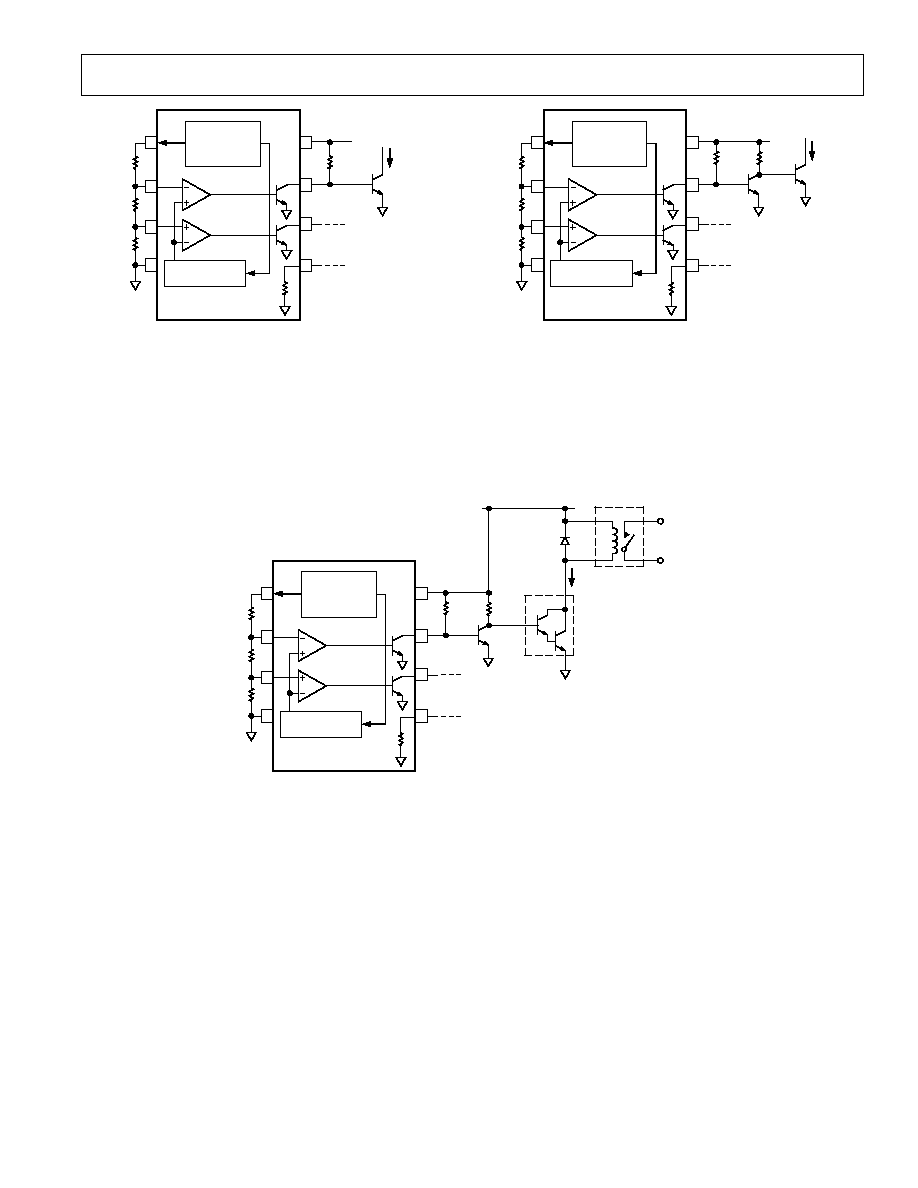
REV. A
TMP12
≠11≠
8
7
6
5
1
2
3
4
TEMPERATURE
SENSOR AND
VOLTAGE
REFERENCE
V
REF
WINDOW
COMPARATOR
HYSTERESIS
GENERATOR
100
TMP12
VPTAT
4.7k
2N1711
V+
I
C
Q1
Figure 15. An External Transistor Minimizes Self-Heating
8
7
6
5
1
2
3
4
TEMPERATURE
SENSOR AND
VOLTAGE
REFERENCE
V
REF
WINDOW
COMPARATOR
HYSTERESIS
GENERATOR
100
TMP12
VPTAT
4.7k
2N1711
V+
I
C
Q1
4.7k
2N1711
Q2
Figure 16. Second Transistor Maintains Polarity of TMP12
Output
An example of a higher power transistor is a standard Darlington
configuration as shown in Figure 16. The part chosen, TIP-110,
can handle 2 A continuous which is more than enough to con-
trol many high-power relays. In fact, the Darlington itself can be
used as the switch, similar to MOSFETs and IGBTs.
8
7
6
5
1
2
3
4
TEMPERATURE
SENSOR AND
VOLTAGE
REFERENCE
V
REF
WINDOW
COMPARATOR
HYSTERESIS
GENERATOR
100
TMP12
VPTAT
4.7k
2N1711
V+
I
C
4.7k
TIP-110
5V
MOTOR
SHUTDOWN
RELAY
12V
Figure 17. Darlington Transistor Can Handle Large Currents
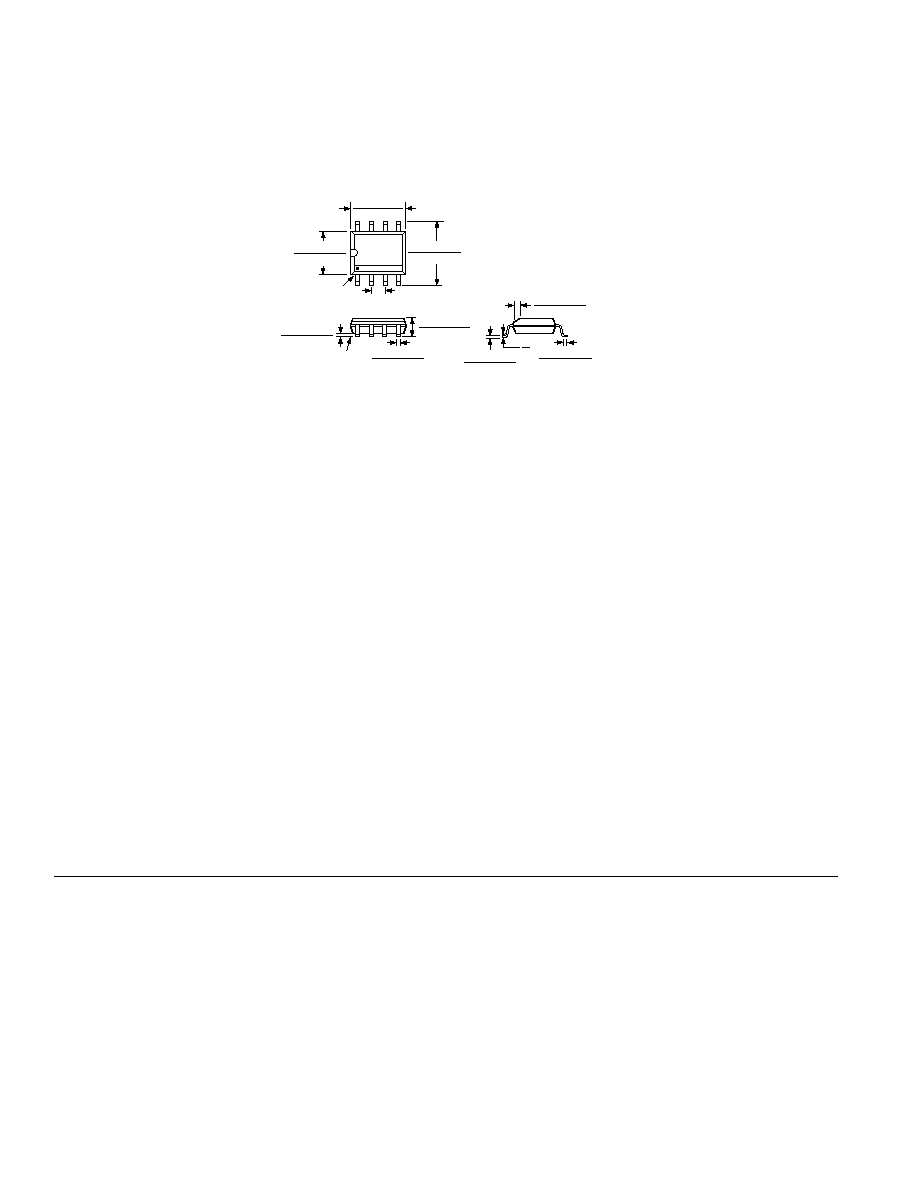
≠12≠
C00335≠0≠2/02(A)
PRINTED IN U.S.A.
OUTLINE DIMENSIONS
Dimensions shown in inches and (mm).
8-Pin SOIC
0.0098 (0.25)
0.0075 (0.19)
0.0500 (1.27)
0.0160 (0.41)
8
0
0.0196 (0.50)
0.0099 (0.25)
45
8
5
4
1
0.1968 (5.00)
0.1890 (4.80)
0.2440 (6.20)
0.2284 (5.80)
PIN 1
0.1574 (4.00)
0.1497 (3.80)
0.0500 (1.27)
BSC
0.0688 (1.75)
0.0532 (1.35)
SEATING
PLANE
0.0098 (0.25)
0.0040 (0.10)
0.0192 (0.49)
0.0138 (0.35)
Revision History
Location
Page
09/01--Data Sheet changed from REV. 0 to REV. A.
Edits to GENERAL DESCRIPTION . . . . . . . . . . . . . . . . . . . . . . . . . . . . . . . . . . . . . . . . . . . . . . . . . . . . . . . . . . . . . . . . . . . . . . . . 1
Edits to PINOUTS Figure . . . . . . . . . . . . . . . . . . . . . . . . . . . . . . . . . . . . . . . . . . . . . . . . . . . . . . . . . . . . . . . . . . . . . . . . . . . . . . . . . 1
Deleted WAFER TEST LIMITS . . . . . . . . . . . . . . . . . . . . . . . . . . . . . . . . . . . . . . . . . . . . . . . . . . . . . . . . . . . . . . . . . . . . . . . . . . . 3
Deleted DICE CHARACTERISTICS . . . . . . . . . . . . . . . . . . . . . . . . . . . . . . . . . . . . . . . . . . . . . . . . . . . . . . . . . . . . . . . . . . . . . . . 3
Edits to PACKAGE TYPE . . . . . . . . . . . . . . . . . . . . . . . . . . . . . . . . . . . . . . . . . . . . . . . . . . . . . . . . . . . . . . . . . . . . . . . . . . . . . . . . 3
Edits to ORDERING GUIDE . . . . . . . . . . . . . . . . . . . . . . . . . . . . . . . . . . . . . . . . . . . . . . . . . . . . . . . . . . . . . . . . . . . . . . . . . . . . . . 3
Edits to TYPICAL PERFORMANCE CHARACTERISTICS . . . . . . . . . . . . . . . . . . . . . . . . . . . . . . . . . . . . . . . . . . . . . . . . . . . . . 4
Edits to OUTLINE DIMENSIONS Figure . . . . . . . . . . . . . . . . . . . . . . . . . . . . . . . . . . . . . . . . . . . . . . . . . . . . . . . . . . . . . . . . . . 12











